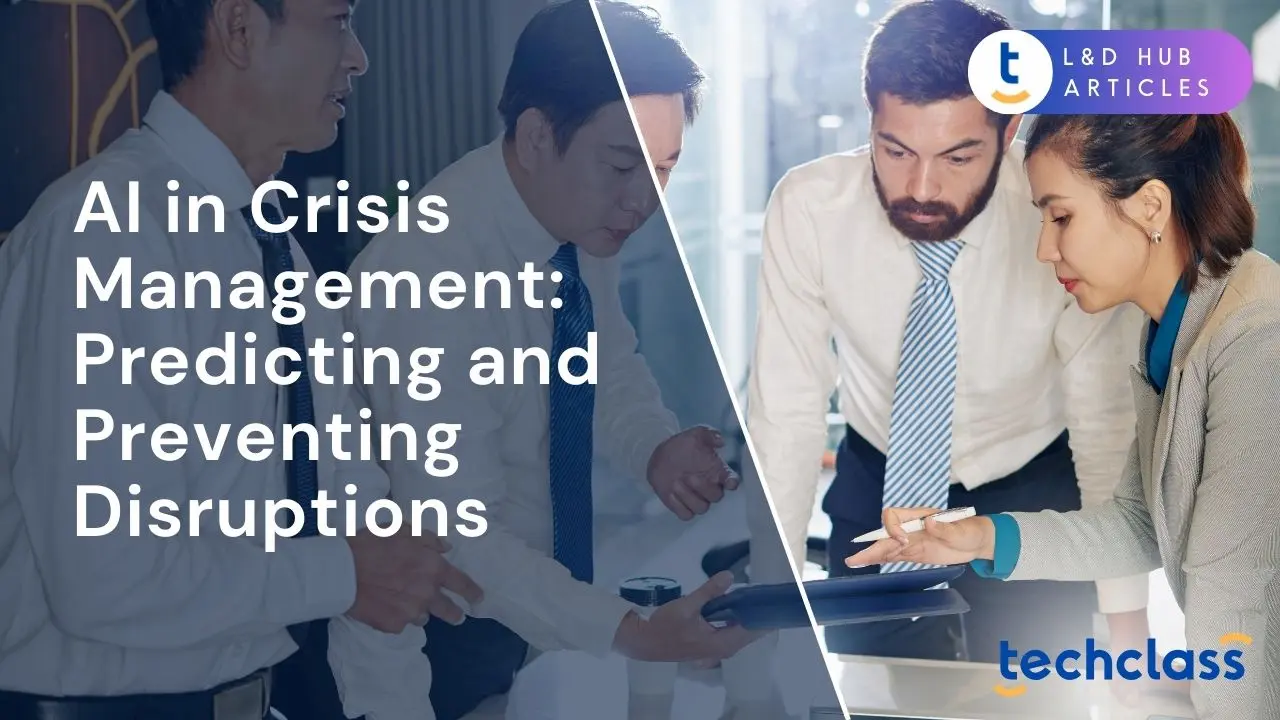
In an era of global uncertainty, businesses face an unprecedented range of crises, from pandemics and natural disasters to cyberattacks and supply chain failures. Traditional crisis management often reacts after disruption strikes. Today, artificial intelligence (AI) offers a powerful alternative: the ability to anticipate and even prevent many disruptions before they spiral out of control. By rapidly analyzing vast data streams and spotting early warning signs, AI-driven systems can give leaders precious lead time to act. Research suggests that machine learning algorithms can detect subtle patterns signaling a looming crisis, essentially sounding the alarm while there’s still time to intervene. In other words, AI is shifting crisis management from a primarily reactive exercise to a proactive, predictive strategy. This article explores how AI technologies are transforming crisis management, helping organizations predict potential emergencies and mitigate disruptions, and what enterprise leaders and HR professionals should know about leveraging AI for resilience.
AI in crisis management refers to deploying intelligent technologies, such as machine learning models, natural language processing, and data analytics, to identify, assess, and respond to critical events. Rather than relying solely on human intuition or slow manual processes, AI systems continuously sift through data from diverse sources (e.g. sensor feeds, news reports, social media, internal systems) to detect anomalies and emerging threats. To fully leverage these intelligent technologies, organizations are increasingly investing in AI training to ensure their teams can effectively implement and manage such systems. By analyzing huge volumes of information in real time, AI helps organizations foresee potential risks and craft effective response strategies more quickly. This dramatically improves on traditional crisis management, making it faster, more data-driven, and far more adaptive to unforeseen events.
Importantly, AI doesn’t replace human decision-makers; it augments them. In high-pressure situations, AI can provide decision support by rapidly crunching numbers and even suggesting courses of action, while human leaders apply judgement and context. For example, an AI platform might automatically flag a sudden drop in network activity as a possible cybersecurity breach, alert the IT team, and even initiate preliminary containment protocols, all within seconds. Meanwhile, experts verify the threat and decide on broader strategy. In essence, AI serves as a tireless sentry and analyst, freeing humans to focus on high-level decision-making and communication. This partnership between human expertise and AI’s speed/precision forms the cornerstone of modern, resilient crisis management.
One of AI’s most powerful contributions is the ability to predict crises before they fully emerge. Advanced algorithms excel at continuous monitoring and pattern recognition, giving organizations “early warning radar” across many risk domains. AI-driven analytics can identify subtle indicators of trouble, often invisible to humans, by learning from historical data and real-time signals. For instance, AI tools can highlight single points of failure and monitor key indicators of disruption (such as a sudden spike in the price of raw materials or an unusual increase in system downtime) to warn organizations of brewing problems. Machine learning models excel at extrapolating trends from the past and present, enabling them to forecast potential outcomes and impacts. This means companies can be alerted to a possible crisis weeks in advance and take preventive action rather than being blindsided.
Consider supply chain operations, where delays or shortages can cripple a business. Traditional systems often fail to anticipate issues like a supplier’s factory shutdown or a looming transport strike. AI now changes the game. In 2024, U.S. companies faced an average yearly cost of $228 million due to supply chain disruptions from labor strikes, extreme weather, geopolitical events, and other crises. Predictive AI tools can analyze myriad data points, from weather forecasts to news about port closures, and flag likely disruptions early. Businesses using AI-driven supply chain analytics have been able to identify problems weeks ahead of time, enabling them to source alternatives or reroute shipments. This proactive approach can reduce disruption costs by up to 30% and improve forecast accuracy by 41%, according to industry analyses.
Early warning capabilities extend to other arenas as well. In finance, AI models are being trained to detect patterns that precede market crashes or banking crises, giving risk managers a chance to shore up defenses. One study found that AI-based analytics could outperform traditional methods in predicting financial downturns, alerting stakeholders to looming economic distress and allowing timely interventions to protect assets. In public health, AI systems now monitor epidemiological and social media data to spot outbreaks of disease. A famous example is the Canadian startup BlueDot, which uses AI to scan hundreds of thousands of news reports and airline records daily. BlueDot’s algorithms flagged an unusual cluster of pneumonia cases in Wuhan and warned clients to avoid the area on December 31, 2019, over a week before the World Health Organization announced the COVID-19 outbreak publicly. This illustrates how AI-driven early warnings can literally get ahead of global crises. Whether it’s identifying the spark of a wildfire via satellite images or detecting a surge in negative social media sentiment about a brand (potential PR crisis), AI’s predictive analytics act as an early alarm system. The value of this cannot be overstated: catching a crisis in its infancy can dramatically reduce damage by enabling a faster, more coordinated response.
Prediction is only half the battle, once a threat is detected, swift action is needed to prevent or mitigate disruption. AI contributes here as well, by automating response workflows and optimizing how resources are deployed in a crisis. When every minute counts, AI can initiate predefined contingency steps instantaneously, ensuring nothing falls through the cracks during the chaos. For example, if an AI monitoring system detects a cyber intrusion, it might automatically isolate affected servers, activate backup systems, and notify security personnel, containing the breach before it paralyzes operations. In the context of natural disasters, AI-driven platforms can pull real-time data from weather services and sensors, then automatically create and disseminate alert messages to at-risk facilities and employees. These automated responses buy valuable time and can significantly blunt a crisis’s impact.
AI is also a powerful tool for crisis decision support. During an unfolding emergency, leaders must allocate limited resources, personnel, funds, equipment, in the most effective way. AI’s ability to analyze countless scenarios in milliseconds can guide these tough calls. By simulating different courses of action, AI helps identify which approach will likely save the most lives or minimize downtime. For instance, emergency management teams use AI models to simulate disaster scenarios and optimal resource allocation. If a hurricane is approaching, AI can model various evacuation plans or supply distribution strategies and recommend the one that covers the most people with the resources available. In business contexts, companies use AI simulations to anticipate the ripple effects of a disruption. An AI system can simulate the impact of a major supplier failure on production capacity, helping management decide how to reallocate inventory or adjust operations to maintain output. These what-if analyses, which would take humans days or weeks, can be done in minutes with AI, providing data-driven guidance for crisis mitigation.
Another critical aspect is communications and coordination, where AI can maintain order amidst chaos. AI-powered communication tools ensure that accurate, consistent information flows to all stakeholders. For example, AI chatbots and automated call systems can handle the surge of inquiries from employees or customers during an incident, providing timely updates or instructions. Internally, AI can help draft status reports and action plans on the fly, so leadership and response teams stay aligned. Some enterprises leverage natural language generation to produce clear advisories or press releases based on live data, saving precious time in crises when messaging is key. Furthermore, AI aids coordination by tracking the status of multiple moving parts (for example, the availability of backup sites, the progress of incident response tasks, or the well-being of personnel) and highlighting where attention is needed most.
AI-driven tools have already shown impressive results in crisis response. The California Department of Forestry and Fire Protection (CAL FIRE) deploys an AI-based image recognition system hooked to over a thousand high-elevation cameras. This system can spot wildfires even before human eyes notice the smoke, enabling firefighters to respond to nascent fires while they’re still small. By catching fires early and guiding crews to the exact location, such AI assistance has helped prevent small flare-ups from becoming massive, uncontrollable wildfires. In corporate settings, AI-based monitoring of IT infrastructure can predict equipment failures and trigger maintenance or switchover to backups without waiting for a human technician, thereby avoiding outages. In sum, AI not only predicts crises but also serves as a first responder of sorts, executing immediate preventative actions and supporting human teams in mounting a fast, effective response to any disruption.
AI’s predictive and responsive capabilities in crisis management are being applied in a wide variety of fields. Here are some notable use cases across industries:
These examples highlight a common theme: AI technologies are augmenting crisis management across virtually every domain. Whether the goal is to protect human life, safeguard assets, or ensure business continuity, AI provides an edge in detecting problems sooner and responding more intelligently. Enterprise leaders in any industry can draw lessons from these use cases to enhance their own crisis preparedness.
Adopting AI for crisis management offers several compelling benefits for organizations aiming to bolster their resilience:
While AI promises significant advantages, business and HR leaders should be mindful of the challenges and limitations that come with integrating AI into crisis management. First, AI systems are only as good as the data and models behind them. Poor data quality or biased algorithms can lead to false alarms or, worse, missed warnings. A case in point: Google’s early flu-tracking AI once wildly overestimated flu cases by 140% due to flawed data inputs. This underscores the need for high-quality, relevant data and ongoing model tuning. Organizations must invest in data governance and continuously validate AI outputs against reality to ensure reliability.
Another concern is the lack of transparency in how complex AI models make decisions. During a crisis, stakeholders may be reluctant to trust a “black box” recommendation without understanding it. It’s important to implement AI in a way that provides explainability or confidence scores for its predictions. Moreover, AI can sometimes produce false positives (raising an alarm for a non-issue) or false negatives (failing to catch a real issue). Human oversight remains crucial. Experts should review AI-generated alerts and analyses, especially for high-stakes decisions, to avoid over-reliance on automation. As one crisis management professional put it, AI is an extension of our resources, not a replacement for human expertise. The human judgment element, leadership, ethical consideration, empathy, continues to be irreplaceable in crises.
Cost and integration hurdles are practical considerations as well. Deploying advanced AI tools and training models can be expensive and time-consuming. Smaller organizations might struggle with the needed investments in infrastructure and talent. However, cloud-based AI services and off-the-shelf solutions are increasingly available to bridge this gap. There is also the challenge of integrating AI into existing crisis workflows and ensuring staff are trained to work alongside these tools. Change management and skill development (both in IT and in crisis response teams) are necessary to realize AI’s benefits fully.
Finally, ethical and regulatory issues must be addressed. AI systems in crisis management may process sensitive information (like personal data during a disaster or employee data during a cybersecurity incident). Ensuring privacy and compliance with regulations is paramount. Additionally, as AI takes a larger role, questions of accountability arise, for instance, if an AI fails to predict a crisis, who is responsible? Establishing clear governance, as well as legal and ethical guidelines for AI use, is critical as part of any implementation. In summary, while AI can greatly enhance crisis management, organizations should proceed thoughtfully, combining the technology with robust human oversight, clear governance, and a realistic understanding of its limits.
AI is rapidly becoming an indispensable ally in the quest for organizational resilience. Enterprise leaders and HR professionals across industries should recognize that “business as usual” is no longer sufficient when disruptions loom large on the horizon. Incorporating AI into crisis management and business continuity planning can equip organizations to weather storms that would otherwise cause major upheaval. By predicting risks early and enabling swift, targeted responses, AI gives businesses the opportunity to prevent many crises outright or drastically reduce their impact. Those companies that have adopted AI tools for emergency management, risk monitoring, or supply chain intelligence are already reaping benefits in agility and reduced downtime. Conversely, organizations that ignore these advancements may find themselves struggling with slow reactions, information overload, and avoidable losses when crises hit.
That said, success in this arena is not just about technology—it’s about strategy and culture. Leadership must champion a proactive, data-informed mindset for crisis preparedness. This includes investing in the right AI solutions, but also training teams to interpret and act on AI insights, and fostering collaboration between AI systems and human expertise. When implemented thoughtfully, AI can augment human decision-making and harden an organization’s defenses without undermining the human values and judgment at the heart of crisis leadership. As we move forward, the organizations that blend the best of AI capabilities with skilled, adaptive teams will be the ones best positioned to navigate whatever disruptions come next. Embracing AI for crisis management is ultimately about building a smarter, faster, and more resilient organization, one that can not only survive crises, but confidently prevent and mitigate them for a safer future.
AI in crisis management involves using technologies like machine learning, natural language processing, and data analytics to detect, assess, and respond to threats. It processes large volumes of data from multiple sources in real time, spotting anomalies and emerging risks so leaders can take action before disruptions escalate.
AI uses predictive analytics to monitor and analyze data patterns, learning from historical and real-time inputs to identify early signs of trouble. For example, AI can forecast supply chain delays, detect unusual financial activity before a market downturn, or flag health risks before outbreaks spread widely.
Once a threat is detected, AI can trigger automated response protocols, optimize resource allocation, and assist in decision-making. It can isolate compromised systems in cyberattacks, coordinate emergency alerts during natural disasters, and simulate scenarios to find the most effective response strategies.
Industries such as disaster response, manufacturing, retail, finance, public health, and cybersecurity use AI to enhance crisis detection and response. For example, CAL FIRE uses AI image recognition to spot wildfires early, while supply chain platforms use AI to anticipate disruptions and reroute goods.
Challenges include ensuring high-quality data, avoiding over-reliance on “black box” systems, integrating AI into existing workflows, managing costs, and addressing ethical and privacy concerns. Human oversight remains essential to verify AI’s outputs and guide high-stakes decisions.


